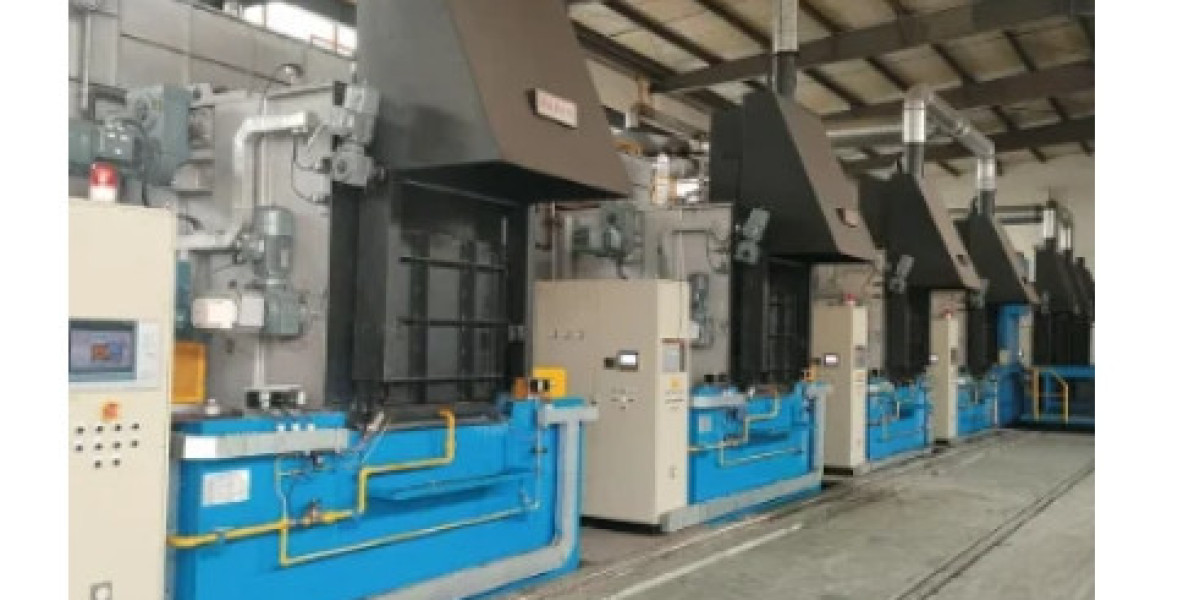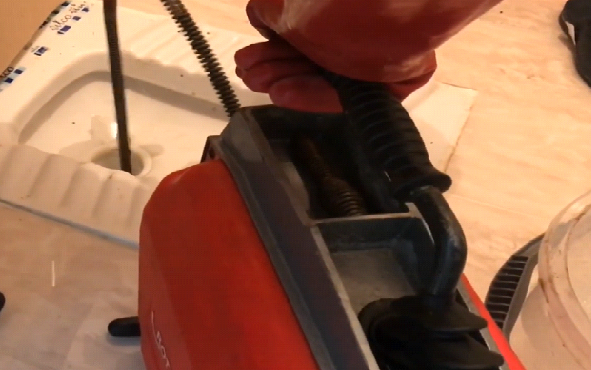In the realm of industrial processes, the atmosphere furnace stands as a crucial tool. This specialized furnace creates controlled environments for heat treatment applications, ensuring precise outcomes. Operating within specific atmospheric conditions, these furnaces play a vital role in enhancing material properties for various industries. Understanding the nuances of an atmosphere furnace's operation is essential for optimizing production processes and achieving desired results efficiently. Join us as we delve into the workings and significance of the atmosphere furnace in industrial settings.
Understanding Atmosphere Furnaces
Functionality
Atmosphere furnaces are designed to control the environment within the furnace during heat treatment processes. They enable precise manipulation of the atmosphere, including gases like carbon monoxide and preventing unwanted reactions like oxidation.
Components
The key components of an atmosphere furnace include a vacuum pump for creating the desired atmospheric conditions, a heating element for generating heat, and a control system for regulating the temperature and atmosphere. The door is crucial for accessing the interior while maintaining the controlled environment.
Types
Atmosphere furnaces can be categorized based on the type of atmosphere they create. Common types include vacuum furnaces that operate in a low-pressure environment, inert gas furnaces that use gases like argon or nitrogen, and reactive gas furnaces that utilize gases like hydrogen or carbon monoxide.
Significance of Controlled Atmospheres
Influence on Heat Treatment Quality
Controlled atmospheres in heat treatment play a crucial role in ensuring precise and uniform heating processes. By regulating the environment within the furnace, materials undergo heat treatment under specific conditions, leading to enhanced quality outcomes. The controlled atmosphere helps in minimizing surface defects and ensures consistent hardness levels across treated materials.
Maintaining a controlled atmosphere during heat treatment significantly impacts the microstructure of materials. By controlling factors such as oxygen content, carbon potential, and gas composition, the structure of treated materials can be finely tuned. This process influences the mechanical properties of materials, including their strength, ductility, and toughness. As a result, materials can achieve desired characteristics suitable for various applications.
Prevention of Oxidation and Contamination
One key advantage of utilizing controlled atmospheres in heat treatment is the prevention of oxidation and contamination. Oxidation occurs when materials react with oxygen at high temperatures, leading to surface degradation and undesirable changes in material properties. By creating an environment low in oxygen content, controlled atmospheres effectively shield materials from oxidation, preserving their integrity.
Contamination poses another challenge during heat treatment processes. Unwanted reactions between materials and impurities in the atmosphere can alter material composition and compromise its quality. Through precise control of the furnace atmosphere, contamination risks are minimized, ensuring that treated materials maintain their purity and desired characteristics throughout the heat treatment cycle.
Impact on Material Performance
The use of controlled atmospheres not only safeguards material integrity but also enhances their overall performance. By eliminating oxidation risks and minimizing contamination effects, materials retain their structural stability and functional properties post-treatment. This leads to improved reliability and longevity of components used in critical applications such as aerospace, automotive, and tooling industries.
Applications of Atmosphere Furnaces
Heat Treatment
Atmosphere furnaces are commonly used for heat treatment processes such as annealing, hardening, and tempering metals. These furnaces provide a controlled environment to heat materials at specific temperatures for precise results.
Sintering
Sintering is another vital application of atmosphere furnaces where powdered materials are compacted at high temperatures to form solid structures. This process is crucial in manufacturing ceramics, powders, and other composite materials.
Brazing and Soldering
Atmosphere furnaces play a key role in brazing and soldering operations by creating an oxygen-free environment that prevents oxidation during the joining of metal components. This ensures strong and durable connections.
Crystal Growth
In the field of semiconductor manufacturing, atmosphere furnaces are utilized for crystal growth processes. By maintaining specific atmospheric conditions, these furnaces facilitate the production of high-quality crystals used in electronics.
Powder Metallurgy
For powder metallurgy applications, atmosphere furnaces enable the consolidation of metal powders into solid components through processes like sintering or hot pressing. This method is valued for its ability to produce complex shapes with high precision.

Hydrogen's Impact in Heat Treatment
Role
Hydrogen gas plays a crucial role in heat treatment processes, acting as a protective atmosphere in atmosphere furnaces. It helps prevent oxidation and decarburization of metals during high-temperature operations.
Hydrogen gas is commonly used in annealing, hardening, and sintering processes to achieve specific material properties. Its reducing properties create a favorable environment for achieving desired metallurgical results.
Effects on Microstructure and Properties
The presence of hydrogen can significantly impact the microstructure and properties of treated materials. It can lead to improved ductility and toughness in certain alloys by reducing the formation of brittle phases.
In contrast, excessive hydrogen exposure can cause hydrogen embrittlement, weakening the material's mechanical properties. This phenomenon underscores the importance of precise control over hydrogen levels during heat treatment.
Safety Considerations
When using hydrogen in heat treatment applications, safety considerations are paramount. Proper ventilation systems must be in place to prevent the accumulation of hydrogen gas, which is highly flammable and poses explosion risks.
Operators should regularly monitor hydrogen levels within the furnace atmosphere to ensure they remain within safe limits. Thorough training on handling procedures and emergency protocols is essential to mitigate potential hazards effectively.
Overview of Heat Treatment Atmosphere Types
Neutral Atmosphere
Neutral atmospheres are commonly used in heat treatment processes to prevent oxidation of metals. They consist of a balanced mixture of gases such as nitrogen and hydrogen. This type of atmosphere helps maintain the surface finish of the metal without altering its chemical composition.
Oxidizing Atmosphere
Oxidizing atmospheres promote the formation of oxides on the surface of metals during heat treatment. These atmospheres typically include gases like oxygen, which react with the metal to create a layer of oxide. This process can enhance the hardness and wear resistance of the material.
Carburizing Atmosphere
Carburizing atmospheres are rich in carbon and are utilized to introduce carbon into the surface layer of metals, enhancing their hardness and wear resistance. This type of atmosphere is crucial for processes like carburizing and carbonitriding, where a hardened case is desired.
Selection Criteria for Atmosphere Types
When choosing an atmosphere type for heat treatment, several factors need to be considered. The desired outcome, material being treated, temperature requirements, and the properties needed post-treatment all play a role in selecting the appropriate atmosphere. For instance, if high hardness is required, a carburizing atmosphere would be suitable.
Pros
Neutral atmospheres preserve the metal's surface finish.
Oxidizing atmospheres improve hardness and wear resistance.
Carburizing atmospheres enhance hardness through carbon introduction.
Cons
Neutral atmospheres may not alter material properties significantly.
Oxidizing atmospheres can lead to brittleness if not controlled properly.
Carburizing atmospheres require precise control to avoid excessive carbon diffusion.

Classifying Atmospheres in Heat Treatments
Reactive vs. Non-Reactive
Reactive atmospheres contain elements that chemically react with the material being treated, altering its properties. These atmospheres are crucial for processes like carburizing and nitriding, enhancing surface hardness.
Non-reactive atmospheres, on the other hand, do not chemically interact with the material. They are commonly used for processes like annealing or stress relieving, where maintaining the material's composition is essential.
Suitability for Different Applications
For applications requiring surface modification, such as case hardening, reactive atmospheres like carbon-rich gas are preferred. This promotes diffusion of elements into the material's surface, improving hardness and wear resistance.
In contrast, non-reactive atmospheres like nitrogen or argon are ideal for processes where maintaining a specific composition is critical. These atmospheres prevent undesired reactions while achieving uniform heating during treatments like sintering.
Benefits of Classifying Atmospheres
Enhanced Control: By classifying atmospheres based on reactivity, heat treatment processes can be precisely tailored to achieve desired material properties.
Improved Efficiency: Proper classification ensures that the atmosphere used optimally supports the intended heat treatment process.
Consistent Results: Matching the atmosphere type to the application reduces variability in outcomes, leading to more predictable results.
Benefits of Using Inert Atmospheres
Improved Material Properties
In heat treatment processes, utilizing inert atmospheres offers significant advantages. The use of inert gases like argon or nitrogen helps prevent oxidation on the material's surface. This absence of oxygen minimizes the formation of oxides, leading to improved material properties such as enhanced strength and corrosion resistance. The lack of oxidation results in a cleaner surface finish, reducing the need for extensive post-treatment polishing.
Enhanced Surface Finish
One key benefit of employing inert atmospheres during heat treatment is the contribution to achieving a superior surface finish on treated materials. By eliminating the presence of reactive gases like oxygen, inert atmospheres prevent unwanted reactions that can negatively impact the surface quality. As a result, components processed in inert atmospheres exhibit smoother surfaces with minimal scale formation or discoloration. This improved surface finish is crucial for applications requiring precise dimensions and aesthetic appeal.
Environmental Sustainability
When compared to other atmosphere types used in heat treatment processes, inert atmospheres offer notable environmental benefits. The controlled environment created by inert gases reduces the generation of harmful by-products typically associated with reactive atmospheres. By minimizing emissions and waste production, the use of inert atmospheres promotes environmental sustainability within industrial operations. Furthermore, the ability to recycle and reuse inert gases adds to their eco-friendly profile, making them a preferred choice for companies prioritizing green initiatives.
Exploring the Roles of Gases in Heat Treating
Impact of Carbon Dioxide
Carbon dioxide plays a crucial role in heat treating processes like brazing. When used as a shielding gas, it prevents oxidation during high-temperature brazing operations. This gas creates a protective atmosphere, ensuring clean and strong joints without compromising the material's integrity.
Influence of Ammonia
Ammonia is commonly employed in heat treating for its unique properties. It aids in the process of chemical reactions, facilitating the removal of oxides from metal surfaces. By promoting cleaner metal surfaces, ammonia enhances the effectiveness of subsequent brazing or welding procedures.
Importance of Oxygen Control
Controlling the presence of oxygen is essential in heat treating to achieve desired outcomes. In processes like annealing, where controlled cooling rates are critical, oxygen levels can significantly impact the final material properties. Proper oxygen control ensures consistent results and prevents undesired chemical reactions.
Gas Selection and Material Compatibility
When selecting gases for heat treating, it is vital to consider the material being treated and its specific requirements. Different materials respond differently to various gases during processes like hardening and tempering. Understanding the options available and their effects on different materials is key to achieving optimal results.
Tailoring Gas Atmospheres for Specific Processes
In heat treating operations, tailoring gas atmospheres to suit specific processes is paramount. For instance, in order to achieve precise hardness levels during hardening, adjusting gas compositions becomes crucial. Each step in the heat treating process requires deliberate gas selection to ensure successful outcomes.

Closing Thoughts
The exploration of atmosphere furnaces has shed light on the critical role of controlled atmospheres in heat treatment processes. Understanding the significance, applications, and classifications of these atmospheres is paramount for industries relying on precise heat treatments. Hydrogen's specific impact and the benefits of inert atmospheres have been highlighted, emphasizing the nuanced roles gases play in optimizing heat treatment outcomes.
In conclusion, a comprehensive grasp of atmosphere furnaces and their associated atmospheres is vital for achieving desired material properties efficiently and effectively. Industries must leverage this knowledge to enhance their heat treatment practices, ensuring superior product quality and performance. By staying informed and implementing best practices in atmosphere furnace applications, businesses can elevate their operations and stay ahead in competitive markets.
Frequently Asked Questions
What are atmosphere furnaces used for?
Atmosphere furnaces are primarily used in heat treatment processes to create controlled environments with specific gas compositions, such as oxygen-free or reducing atmospheres. These conditions help enhance material properties during heating and cooling cycles.
How do controlled atmospheres benefit heat treatment processes?
Controlled atmospheres in furnace operations prevent oxidation and decarburization of materials, ensuring uniform heating and cooling. This results in improved mechanical properties, surface finish, and dimensional stability of the treated components.
Why are inert atmospheres preferred in certain heat treatments?
Inert atmospheres, like nitrogen or argon, are chosen for their non-reactive nature that prevents unwanted chemical reactions during heat treatment. They help maintain the integrity of materials by shielding them from oxidation and contamination.
What role does hydrogen play in heat treatment processes?
Hydrogen is commonly used as a reducing gas in atmosphere furnaces to remove oxides from metal surfaces and facilitate sintering processes. It can also improve the ductility and toughness of certain alloys when properly controlled during heat treatment.
How are different types of heat treatment atmospheres classified?
Heat treatment atmospheres can be categorized based on their composition into groups such as oxidizing, carburizing, nitriding, vacuum, inert, or reducing atmospheres. Each type serves specific purposes to achieve desired material properties through controlled thermal processing.








